Note: this blog post is not meant as a guide to identifying and collecting edible mushrooms. If you are interested in learning more about edible mushrooms please check out the Puget Sound Mycological Society (http://www.psms.org/index.php)

As we transition from rainy fall into cold winter I’ve been thinking back on the wondrous world of fall fungi we get to experience here in the Pacific Northwest! Our moderate temperatures and fall rain create perfect conditions for many mushrooms and other fungi to sprout up from soil, tree trunks, and rotten logs all season long. While you can find fungi in the Pacific Northwest year round, the fall is really their time to shine!
What are fungi?
There are two common misconceptions about fungi. One is that all fungi are mushrooms, the second is that they are plants. To set the record straight, and find out what fungi are, we have to go back a little, to biology 101. You may remember that biologists divide all living things into progressively smaller categories. The second largest of these categories are called kingdoms. Most people know the plant and animal kingdoms; without thinking about it too much you might lump mushrooms into the plant kingdom. People have been mistaking fungi for plants for a very long time, so you’re not alone. Mushrooms grow from the ground and they can’t move around, which sounds a lot like a plant! However, unlike plants, that get their energy from the sun, fungi get their energy from organic compounds. Just like you or I might eat a sandwich for lunch to gain energy, a mushroom “digests” material from where it grows. Because we also need to eat to gain energy we are more closely related to mushrooms than we are to plants!
While mushrooms are certainly the most visible fungi, the kingdom is vast and mysterious. Other fungi that you have definitely heard of include yeasts and molds! That’s right, the yeast that leavens your bread and ferments your beer and wine if a fungi! The mold that covers your damp window sill and the bread you left on the counter is a fungi! Just to reiterate, you have more in common with the mold on your window sill than you do with the tree in your yard. Isn’t biology amazing?

These are some of your closest non-animal realtives! From left to right: mold in a petri dish, yeast cells, bleeding hydnellum mushroom.
But what do fungi eat?
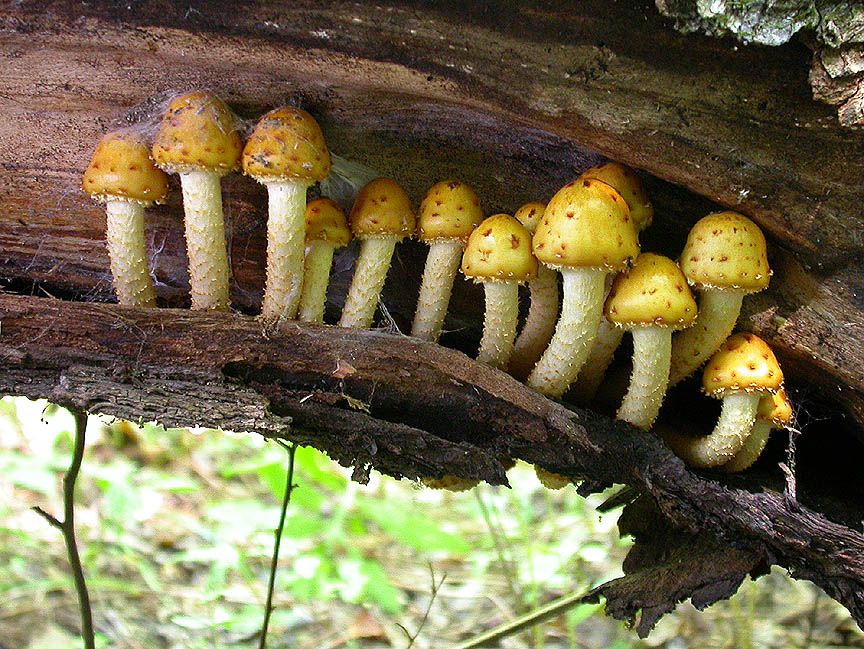
These little mushrooms are hard at work turning this dead piece of wood into beautiful soil.
Fungi are heterotrophs, meaning they need to eat to get energy. But how, and what, do they eat? Most of the fungi we can see are what’s known as decomposers. A decomposer is any organism that can break down material – think dead wood, leaves, or animal carcasses – that has nutrients trapped inside it. In breaking it down the decomposer is able to obtain the nutrients it needs to survive, and the extras are released back into the soil, able to be used by plants, and in turn animals. Decomposers are what create healthy soil! Although other animals, like worms are also decomposers, the majority of them are fungi. So thanks fungi, for helping our forests and food grow!
Standout Fungi of the Puget Sound Region
Confusing Jellies
Orange jelly slime mold, or witch’s butter (Dacrymyces chrysospermus and Tremella aurantia)
This funny fungi is often found growing on decomposing wood. There are actually two distantly related species that resemble one another and are often called by the same name. The orange jelly species illustrate an important point about fungi. It wasn’t until scientists started analyzing fungi DNA that they discovered that many nearly identical species, are actually very distantly related. This leaves us with many questions about mushroom evolution and reproduction.
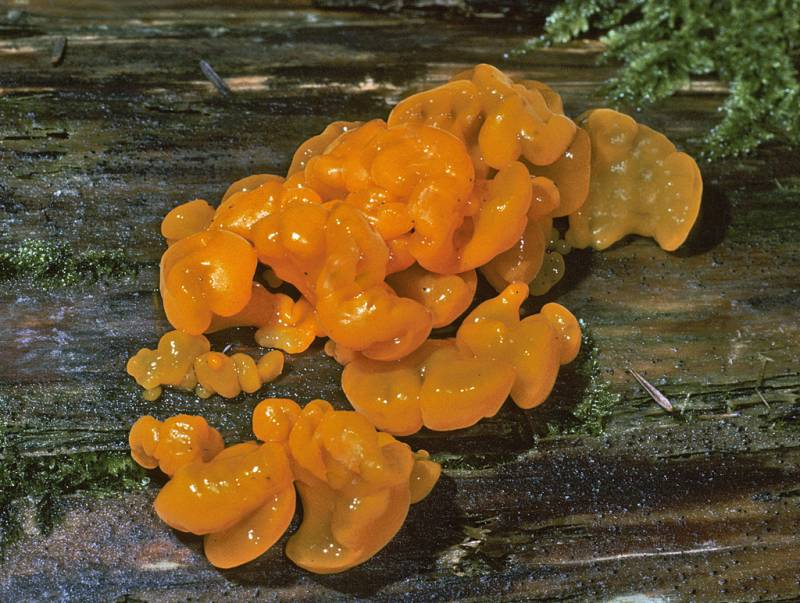
Two Toxic Amanitas
Fly agaric (Amanita muscaria) and death cap (Amanita phalloides)
Most people will recognize this distinctive mushroom with its red cap and white spots. You can find it growing all over the Puget Sound region and it is often what parents show their children as an example of toxic mushrooms. Make no mistake, fly agaric are toxic, and they send people to the hospital every year. However, fly agaric are rarely fatal, and it is the far less conspicuous death cap that can really cause problems if mistakenly ingested. Poison control reports that most deadly mushroom poisoning are due to the death cap, which can easily be confused for button mushrooms. Despite their toxicity, fly agaric have historically been used in northern European shamanic rituals, while technically possible to safely consume them after a special cooking method it is definitely not advised.

Death cap (Amanita phalloides). This unnasuming mushroom does not give away its high level of toxcicity.
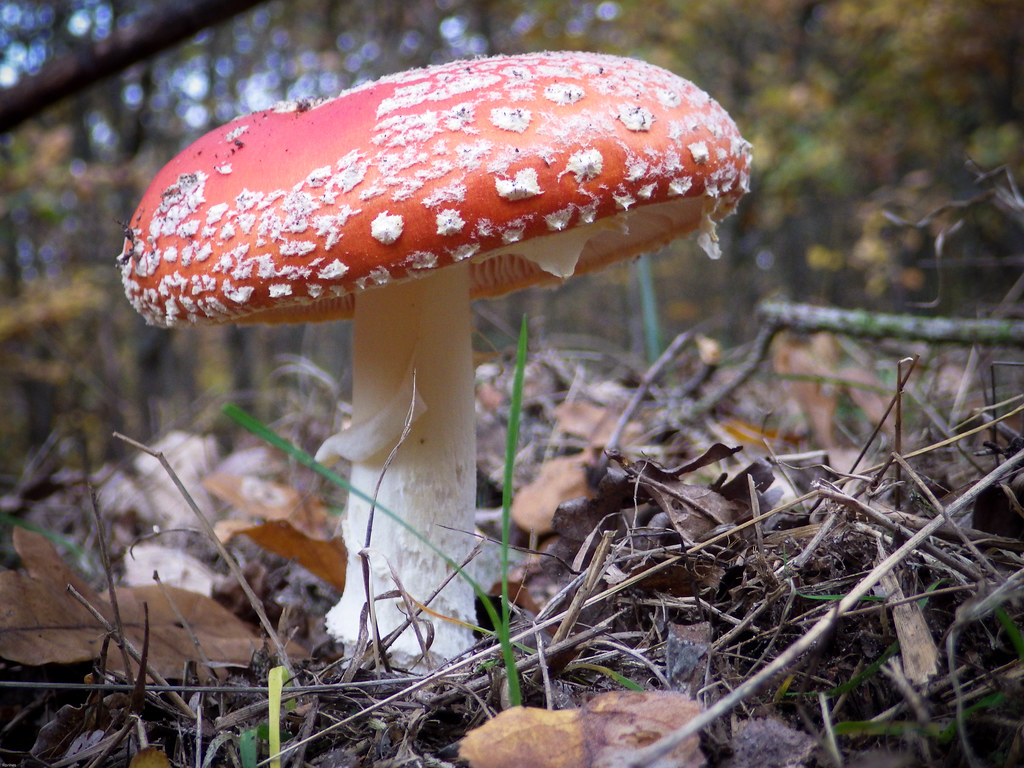
Fly agaric (Amanita muscaria). This distinctive mushroom warns of its toxcicity with bright colors.
Beautiful Boletes
Family Boletacea
This unique group of mushrooms all have small tubes called pores under their cap, as opposed to the more common gills (thin ridges). Boletes come in a variety of sizes, from small and slender, to giant with a bulbous stem. Similarly their colors can vary quite a bit, from beige porcinis, to coffee brown and yellow admirable boletes, to the bright red, and memorably named, Satan’s bolete. Many boletes stain blue when bruised, which can be a useful identification tool when narrowing down species. Whatever the species, shape, or color boletes have a unique appearance that you will soon learn to recognize if you keep your eye out.
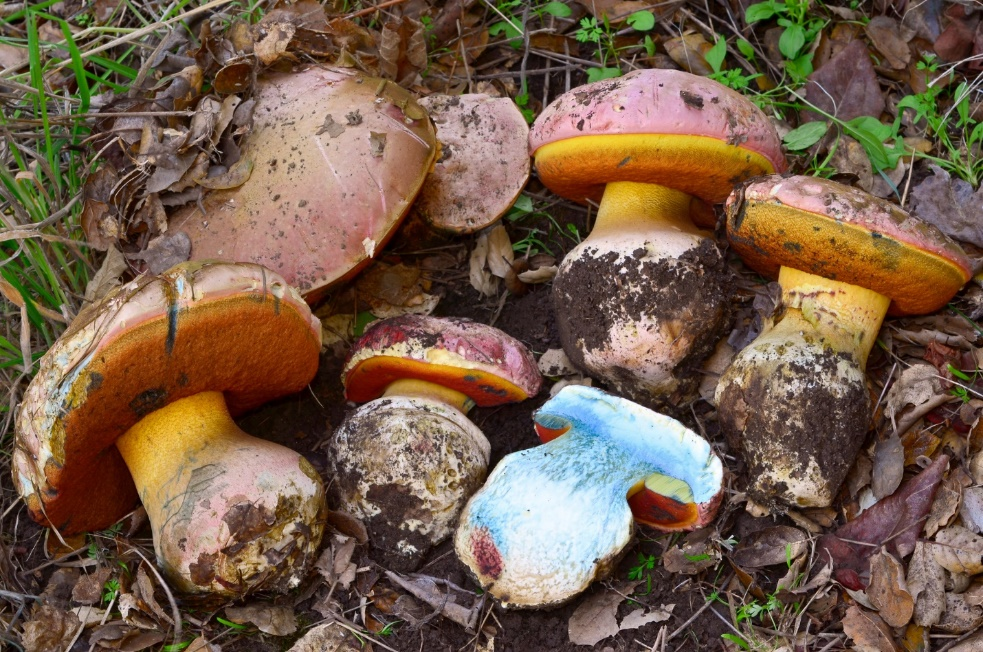
Above: Satan’s bolete (Rubroboletus satanas) showing blue staining when cut. Right: visible pores on an admirable bolete (Aureoboletus mirabilis).
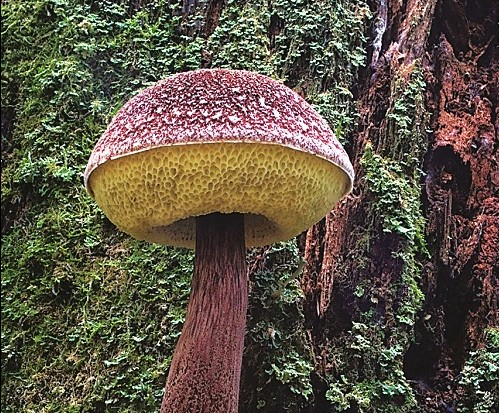
Fungi, Plant Communication, and Restoration
In addition to the beautiful and varied fruiting bodies (the above ground portion of mushrooms), the below ground network of fungi play an important role. Fungi have extensive root systems called mycorrhizae that form massive networks in the soil. These networks function similarly to plant roots, in that they allow allow the fungi to obtain chemical nutrients from the soil and sugars from plants, but they also play a far more massive role in the forest ecosystem. These mycorrhyzal networks connect plants to each other, and even act as a conduit for plants to exchange carbon, nitrogen, and phosphorus, all of which are essential plant nutrients (Finlay & Read, 1986).

The white under the grass is not the roots of the grass, but mycorrhizal fungi!
Trees that are sufficient in carbon, phosphorus, or nitrogen can send these nutrients through the mycorrhyzal network to trees that are lacking nutrients. The older a tree is, the larger and more diverse its network. This means that a seedling planted where it can easily tap into a large, established network may grow better than a seedling that does not have this access (Simard & Durral, 2004).
While this initially sounds very straightforward it gets a little more complicated when we start considering different species. A tree of one species will always be able to tap into the mycorrhyzal network of another tree of the same species, but it may not be able to conect to the network of another tree species. This is becuause different species of fungi associate with different trees. With an estimated three million species of fungi worldwide we have a lot to learn about these relationships!
One thing we do know is that if a seedling is able to take advantage of an eexsisting network it is more likely to survive and thrive. Douglas firs planted beneath mature paper birch trees grew taller and had higher photosyntheitc rates than fir seedlings that were isolated from the birch trees (Simmard et al., 1997). Researchers have also found that acorns planted near live oak trees, or sprouting oak stumps contain more nitrogen and phosphorus than those planted away from existing oaks (Dickie et al., 2002).
In terms of restoration this means a quicker turn around from planting to higher canopy cover, and trees that are more resilient to poor soil quality. The increased photosynthetic rate means that the tree filter more air and sequester more carbon!
This can all sound pretty complicated, and potentially difficult information to use. But because trees of the same species can always access each other’s networks you can start your seedlings off on the right foot by planting closely related species near eachother. Think firs near firs and maples near maples, etc.
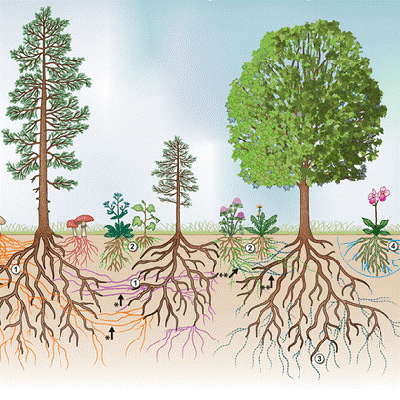
Colored lines represent the mycorrhizal network, with different fungal connections in the forest soil (van der Heijden et al, 2014).
Are you intrested in learning more about the wonderful world of fungi?
A Radiolab episode about Suzanne Simard’s, and others, research into the fungal network that connect trees: https://www.wnycstudios.org/podcasts/radiolab/articles/from-tree-to-shining-tree
Suzanne Simards TED Talk on the same subject: https://www.ted.com/talks/suzanne_simard_how_trees_talk_to_each_other
The Puget Sound Mycological Society hosts many events aimed at helping people learn to identify mushrooms: http://www.psms.org/index.php
David Arora is an excellent author and mycologist. If you’re just getting started on your fungal journey check out: All That the Rain Promises and More: A Hip Pocket Guide to Western Mushrooms
If you’re ready for more advanced, but equally delightful reading, check out: Mushrooms Demystified: A Comprehensive Guide to Fleshy Fungi
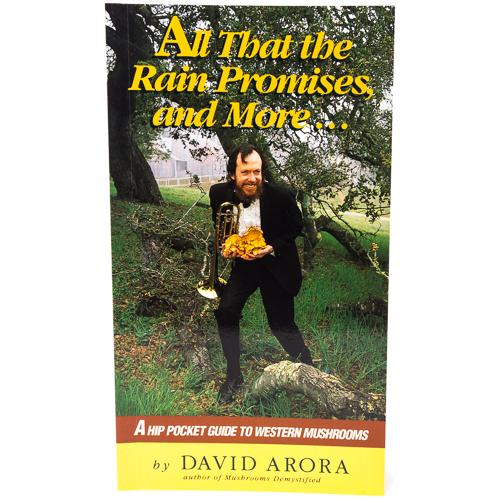
Citations
Babikova, Z., Gilbert, L., Bruce, T. J. A., Birkett, M., Caulfield, J. C., Woodcock, C., … Johnson, D. (2013). Underground signals carried through common mycelial networks warn neighbouring plants of aphid attack. Ecology Letters, 16(7), 835–843. doi: 10.1111/ele.12115
Dickie, I. A., Koide, R. T., & Steiner, K. C. (2002). Influences of Established Trees on Mycorrhizas, Nutrition, and Growth of Quercus rubra Seedlings. Ecological Monographs, 72(4), 505. doi: 10.2307/3100054
Finlay, R. D., & Read, D. J. (1986). The Structure And Function Of The Vegetative Mycelium Of Ectomycorrhizal Plants. I. Translocation Of 14C-Labelled Carbon Between Plants Interconnected By A Common Mycelium. New Phytologist, 103(1), 143–156. doi: 10.1111/j.1469-8137.1986.tb00603.x
Jung, S. C., Martinez-Medina, A., Lopez-Raez, J. A., & Pozo, M. J. (2012). Mycorrhiza-Induced Resistance and Priming of Plant Defenses. Journal of Chemical Ecology, 38(6), 651–664. doi: 10.1007/s10886-012-0134-6
Simard, S. W., Jones, M. D., Durall, D. M., Perry, D. A., Myrold, D. D., & Molina, R. (1997). Reciprocal transfer of carbon isotopes between ectomycorrhizal Betula papyrifera and Pseudotsuga menziesii. New Phytologist, 137(3), 529–542. doi: 10.1046/j.1469-8137.1997.00834.x
Simard, S. W., & Durall, D. M. (2004). Mycorrhizal networks: a review of their extent, function, and importance. Canadian Journal of Botany, 82(8), 1140–1165. doi: 10.1139/b04-116
Song, Y. Y., Zeng, R. S., Xu, J. F., Li, J., Shen, X., & Yihdego, W. G. (2010). Interplant Communication of Tomato Plants through Underground Common Mycorrhizal Networks. PLoS ONE, 5(10). doi: 10.1371/journal.pone.0013324

Madeline.
Wow, great post on my favorite subject, the wonderful world of saprophytes. Especially love that photo of the row of tiny perfect little mushrooms lined up on that bark. I was pulling an old scots broom in Discovery Park last month and I saw the same species, I think clinging to the base of the Scots broom. I’ve been collecting mushroom images from the Park this past fall and winter and have become seduced! Thanks for a great blog!
Thanks Phil!
I was fascinated by the Witch’s Butter I found up in the Olympic peninsula last week. I took photos of so many mushrooms, banana slugs, and fungi. Now I want to learn as much about them as I do about wildflowers!